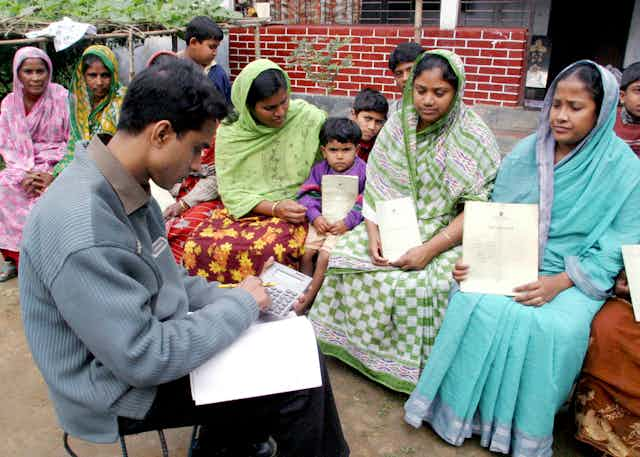The Grameen Bank, a pioneer in lending to the financially vulnerable in the developing world, is partnering a community bank in rural New South Wales. Grameen Bank specialises in giving small loans, also called microfinance, to people who use it to pay for things such as a new roof or to small businesses, to buy stock for example.
But to be legally allowed to access capital markets, and accept and lend out customer savings, microfinance providers like Grameen Bank have to follow the same regulations as large financial institutions. These conditions are too hard for many microfinance providers to meet, so the sector relies on donations and grants for funding. This is unsustainable.
Read more: How microfinance reduces gender inequality in developing countries
Grameen Bank’s model does have potential to help a lot of Australians. While we have one of the strongest financial sectors in the world, millions of Australians lack access to basic financial services and products, such as transaction accounts, general insurance and a credit card.
Studies also show the benefits of microfinance are wider than just giving people access to finance. Women especially benefit from microfinance as many loans are made to and by women, so it puts money and decision-making in the hands of women who otherwise wouldn’t have it.
There is also a debate over the trade-off between more financial inclusion and the risk of people taking on debt that they can’t pay back due to microfinance. In the Indian state of Andhra Pradesh, for example, many rural farmers repeatedly took out loans, using one loan to repay another. The crisis resulted in series of suicides by farmers caught in a cycle of debt.
Without regulation that protects borrowers from taking on debt they can’t afford, this could occur in Australia as well.
What’s different about the Grameen Bank model is that it doesn’t ask for collateral as security for the loans, as a “payday lender” or a pawn shop might. Instead, loans are made to borrowers who have five references from people in the community (not relatives) regarding their ability and intent to repay the loan.
The loans are generally for one year, with strict weekly repayments, and interest set at around 30%. The five references provide what’s called “social collateral” or peer pressure, resulting in repayment rates of around 99%.
While this model works in close-knit communities in Bangladesh, it does not translate exactly to countries like Australia.
Studies show borrowers benefit from feeling more empowered and being financially included in society because of access to microfinance.
But there are many critics of microfinance. Studies have found that because of the high interest rates charged by microfinance providers, the increases in business investment and profitability don’t lead to higher consumption or improved health and education. Researchers have also found that microfinance means children are kept home to help run the expanded businesses, so their school attendance is reduced.
Read more: Microfinance could wind up being the new subprime
When it comes to developed countries like Australia, microfinance also has mixed results. One of the problems is that in developed countries microfinance lenders are often subsidiaries of large banks, such as Banca Prossima in Italy. These banks often aren’t successful in delivering microfinance because of their focus on profits.
The Grameen Bank has had some success in the United States. But this success has come in niche areas, with many customers being illegal immigrants, Latino communities and those who are historically persecuted.
When this niche success is considered in the Australian context, Grameen’s potential is less apparent. Australia has few illegal residents, and not many Indigenous Australians live in the rural hubs that Grameen Bank is targeting.
But the regulatory hurdles are the biggest issue facing Grameen Bank in Australia. On top of the need to protect borrowers, Grameen Bank faces a problem funding its operations. In developing countries like Bangladesh, microfinance providers have access to savings and capital markets to fund their operations. This is also how our mainstream banks, such as the Commonwealth Bank, fund themselves.
But because of the heavy financial regulations in Australia, the few microfinance providers, such as Foresters and Many Rivers, are forced to fund themselves through grants and donations. Grameen Bank will need to follow a similar model in a shrinking grant environment.
For Grameen Bank and organisations like it to be viable in Australia, separate regulation is needed. The microfinance sector in Australia needs to be able to take deposits and lend them out, and to access capital markets and equity partnerships. This would put Grameen Bank and other microfinance providers on a more sustainable footing.
We can take some guidance from Bangladesh, where Grameen Bank is from, and which has specific microfinance regulations. The government has legislated this because of the important role Grameen Bank plays in financial inclusion, and because it is partially owned by the government.

